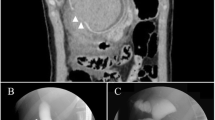Abstract
We report two cases of pneumoperitoneum following endoscopic retrograde cholangiopancreatography for retained common bile duct (CBD) stones. These post-cholecystectomy patients underwent sphincterotomy, CBD clearance, and “T” tube removal at the same time. Post-procedure, both of the patients developed pneumoperitoneum. Pneumoperitoneum developed as a result of air traversing from the duodenum to the peritoneum through the ruptured “T” tube tract. “T” tube removal in the same sitting as sphincterotomy and CBD clearance may lead to pneumoperitoneum, which can be managed conservatively.




Similar content being viewed by others
References
Freeman ML, Nelson DB, Sherman S, et al. Complications of endoscopic biliary sphincterotomy. N Engl J Med. 1996;335:909–918.
Masci E, Toti G, Mariani A, et al. Complications of diagnostic and therapeutic ERCP: a prospective multicenter study. Am J Gastroenterol. 2001;96:417–423.
Loperfido S, Angelini G, Benedetti G, et al. Major early complications from diagnostic and therapeutic ERCP: a prospective multicenter study. Gastrointest Endosc. 1998;48:1–10.
Colton JB, Curran CC. Quality indicators, including complications, of ERCP in a community setting: a prospective study. Gastrointest Endosc. 2009;70:457–467.
Howard TJ, Tan T, Lehman GA, et al. Classification and management of perforations complicating endoscopic sphincterotomy. Surgery. 1999;126:658–663. (discussion 664–665).
Aliperti G. Complications related to diagnostic and therapeutic endoscopic retrograde cholangiopancreatography. Gastrointest Endosc Clin N Am. 1996;6:379–407.
Genzlinger JL, McPhee MS, Fisher JK, et al. Significance of retroperitoneal air after endoscopic retrograde cholangiopancreatography with sphincterotomy. Am J Gastroenterol. 1999;94:1267–1270.
Dunham F, Bourgeois N, Gelin M, et al. Retroperitoneal perforations following endoscopic sphincterotomy. Clinical course and management. Endoscopy. 1982;14:92–96.
Della Libera F, Ferrari Junior AP. Asymptomatic pneumoperitoneum after endoscopic treatment of pseudocysts. Endoscopy. 1997;29:231–232.
Mergener K, Jowell PS, Brauch MS, Baille J. Pneumoperitoneum complicating ERCP performed immediately after EUS-guided fine-needle aspiration. Gastrointest Endosc. 1998;47:541–542.
Enns R, Eloubedi MA, Mergener K, et al. ERCP-related perforations: risk factors and management. Endoscopy. 2002;34:293–298.
Bar Meir S, Lang A, Shemesh E, et al. Pneumoperitoneum after insertion of endoscopic biliary stent for post cholecystectomy biliary leak. Gastrointest Endosc. 1993;39:818–820.
Conflict of interest
None.
Author information
Authors and Affiliations
Corresponding author
Rights and permissions
About this article
Cite this article
Singh, V., Singh, G., Verma, G.R. et al. Pseudobowel Perforation Following Endoscopic Retrograde Cholangiopancreatography. Dig Dis Sci 58, 1781–1783 (2013). https://doi.org/10.1007/s10620-012-2538-0
Received:
Accepted:
Published:
Issue Date:
DOI: https://doi.org/10.1007/s10620-012-2538-0




